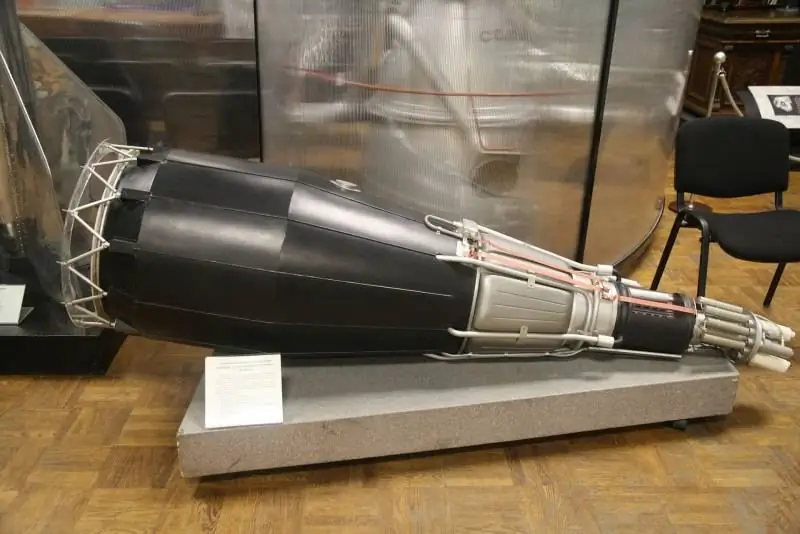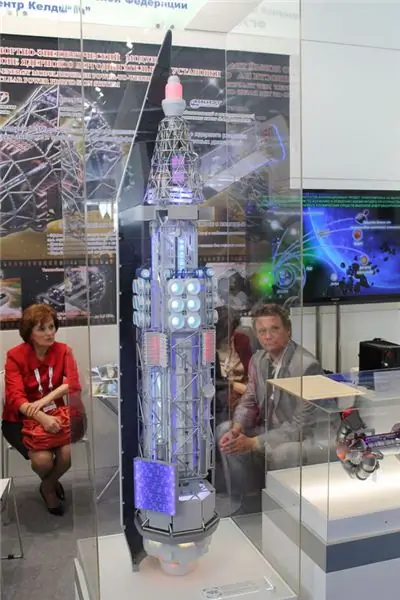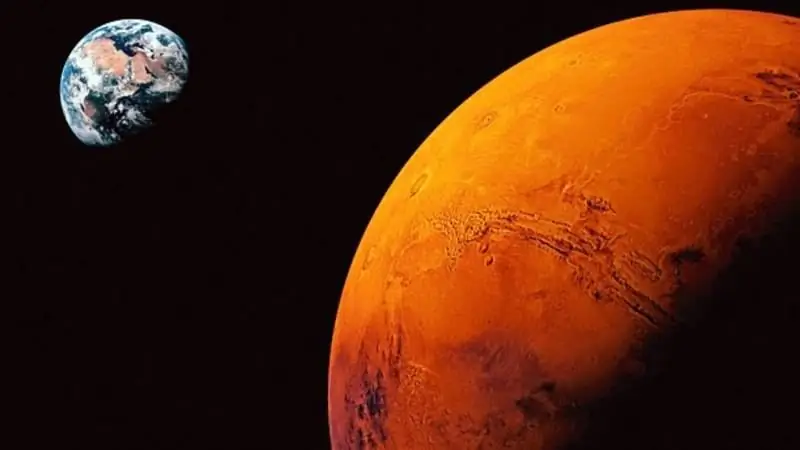- Author Matthew Elmers [email protected].
- Public 2023-12-16 21:49.
- Last modified 2025-01-24 09:17.
One of the most ambitious Soviet-Russian projects in the field of space exploration is close to completion and is entering the stage of immediate practical implementation. We are talking about the creation of a nuclear power plant of a megawatt class. The creation and testing of such an engine can significantly change the state of affairs in near-earth space.
The megawatt class nuclear power plant (NPPU) is a joint project of a group of Russian enterprises that are part of Roscosmos and Rosatom. This project is aimed at developing a megawatt class nuclear power plant. It is designed specifically to equip a new spacecraft with the working name TEM (transport and energy module). The main executor of work on the project of creating a nuclear power plant is the Federal State Unitary Enterprise "Research Center named after M. V. Keldysh" (Moscow). The goal of the ambitious project is to bring Russia to a leading position in the creation of energy complexes for space purposes, which are highly efficient and capable of solving an impressive range of tasks in outer space. For example, exploration of the Moon, as well as distant planets of our solar system, including the creation of automatic bases on them.
Currently, space flights in near-earth space are carried out on rockets, which are set in motion due to the combustion of liquid or solid rocket fuel in their engines. Liquid rocket fuel is divided into an oxidizer and a fuel. These components are in the various tanks of the rocket in a liquid state. The mixing of the components takes place already in the combustion chamber, usually by means of injectors. The pressure is created due to the work of a displacement or turbo pump system. In addition, the propellant components are used to cool the rocket engine nozzle. Solid rocket fuel is also divided into fuel and oxidizer, but they are in the form of a mixture of solids.

Over the past decades, the technology of using these types of rocket fuel has been perfected to the smallest detail in many countries. At the same time, the rocket scientists themselves admit that the further development of such technologies is problematic. Former head of the Russian Federal Space Agency Anatoly Perminov noted: “Roughly speaking, everything has been squeezed out of the existing rocket engines, whether liquid or solid. Attempts to increase their thrust, specific impulse seem to be simply hopeless. Against this background, other technical solutions are of interest. For example, nuclear power plants, which can provide an increase in thrust and specific impulse at times. Anatoly Perminov gave an example of a flight to Mars, to which it is now necessary to fly 1, 5-2 years there and back. With the use of a nuclear propulsion system, the flight time could be reduced to 2-4 months.
Taking this into account, in Russia, since 2010, a project is being implemented to create a space transport and power module based on a megawatt-class nuclear power plant that has no analogues in the world. The corresponding order was signed by Dmitry Medvedev. For the implementation of this project until 2018 from the federal budget, Roscosmos and Rosatom, it was planned to allocate 17 billion rubles, 7, 2 billion rubles of this amount was allocated to the state corporation Rosatom for the creation of a reactor facility (Research and Design Institute Dollezhal Energy Technicians), 4 billion rubles - to the Keldysh Center for the development of a nuclear power propulsion system, 5.8 billion rubles - to RSC Energia, which was supposed to create a transport and energy module. In accordance with the new federal space program in 2016-2025, it was envisaged to allocate another 22 billion 890 million rubles for further work on the project.
All these works are carried out in Russia not from scratch. The possibility of using nuclear energy in space has been considered since the mid-1950s by such prominent Russian specialists as Keldysh, Kurchatov and Korolev. From 1970 to 1988 alone, the Soviet Union launched more than 30 reconnaissance satellites into space, which were equipped with low-power nuclear power plants such as Topaz and Buk. These satellites were used to create an all-weather surveillance system for surface targets throughout the entire water area of the World Ocean, as well as to issue target designation with transmission to command posts or weapons carriers - the Legend marine space reconnaissance and target designation system (1978). Also, in the period from 1960 to 1980, a nuclear rocket engine was developed and tested in our country at the Semipalatinsk test site, the TASS agency reported.

Nuclear reactor-converter "Topaz" (reduced model)
Experts highlight the following advantages of nuclear power propulsion systems:
- The ability to fly to Mars in 1, 5 months and return back, while a flight using conventional rocket engines can take up to 1, 5 years without the possibility of returning back.
- New opportunities in the study of near-earth space.
- The ability to maneuver and accelerate, in contrast to installations that can only accelerate and then fly along a given trajectory.
- Reducing maintenance costs, which is achieved due to a high resource, 10-year operation is possible.
- A significant increase in the payload mass put into orbit due to the absence of large fuel tanks.
On July 20, 2014, a patent of the Russian Federation was received under the number RU2522971 for the "Nuclear Power Propulsion Plant" (NPP), the author is academician A. Koroteev. Later, at the exhibition "State Order - FOR Fair Procurement 2016", JSC "NIKIET" named after Dollezhal presented a model of a reactor plant for a nuclear power plant of a megawatt class. It is known that the nuclear power plant being developed in our country consists of three main elements: a reactor plant with a working fluid and auxiliary devices, such as a turbine generator-compressor and a heat exchanger-recuperator; an electric propulsion system and a radiator refrigerator (a system for dumping heat into space). Considering the progress of work, it can be noted that the Russian Federation has every chance of being the first to launch a spacecraft into orbit, which will be equipped with a nuclear power plant.
It is planned that a model of a nuclear power plant in iron for testing will be created by 2019. And the first flights into space using such a power plant will take place in the 2020s. Dmitry Makarov, director of the Institute of Reactor Materials (IRM, Sverdlovsk Region), told journalists back in April 2016 that the first flight tests of a nuclear space propulsion system were planned for the 2020s. Answering questions from TASS journalists, he noted that in the near future a ground-based prototype stand of this device will be created in Russia, and the first flight tests in space will take place in the 2020s. Such an installation of a megawatt class will make it possible to form powerful electric nuclear engines that can accelerate interplanetary vehicles to serious speeds. As part of this project, Rosatom is creating the heart of the facility - a nuclear reactor.

Model of a reactor plant for a nuclear power plant of a megawatt class
According to Makarov, the IRM successfully completed the tests of heat-conducting elements (TVELs) for this installation, specifying that they tested full-scale fuel elements, which are planned to be used in such reactors. Makarov has no doubt that based on the experience and competence of the Roscosmos and Rosatom institutes, it will be possible to create a nuclear power propulsion system that will allow our country to reach not only the nearest, but also distant planets of our solar system. In fact, a platform will be developed with the help of which it will be possible to implement serious research programs aimed at studying deep space.
The development of a nuclear power plant in Russia has the following practical benefits. Firstly, this is a significant expansion of the capabilities of Russia and mankind in general. Nuclear-powered spacecraft will make human travel to Mars and other planets a reality.
Secondly, such ships will significantly enhance human activity in near-Earth space, giving a real opportunity to start colonizing the Moon (there are already projects to build nuclear power plants on the Earth's satellite). “The use of nuclear power plants is being considered for large manned space systems, and not for small spacecraft that can fly on other types of installations using ion engines or solar wind energy. It will be possible to use nuclear power propulsion systems on reusable interorbital tugs. For example, to move various cargoes between low and high orbits, to perform flights to asteroids. It will also be possible to send an expedition to Mars or create a reusable lunar tug,”says Professor Oleg Gorshkov. Such ships are able to change the entire economy of space exploration. As RSC Energia specialists note, a nuclear-powered launch vehicle will be able to reduce the cost of launching a payload into a circumlunar orbit by more than two times compared to rockets equipped with liquid-propellant rocket engines.

Thirdly, this development is new technologies and materials that will surely appear during the implementation of the project. They can be introduced into other branches of Russian industry - mechanical engineering, metallurgy, etc. This is a breakthrough project that, if successfully implemented, can give a new impetus to the Russian economy.






